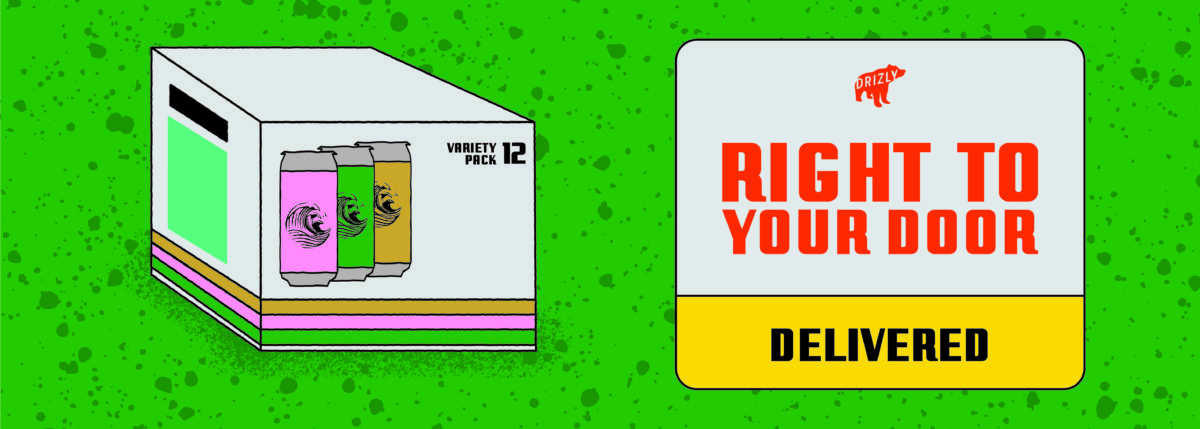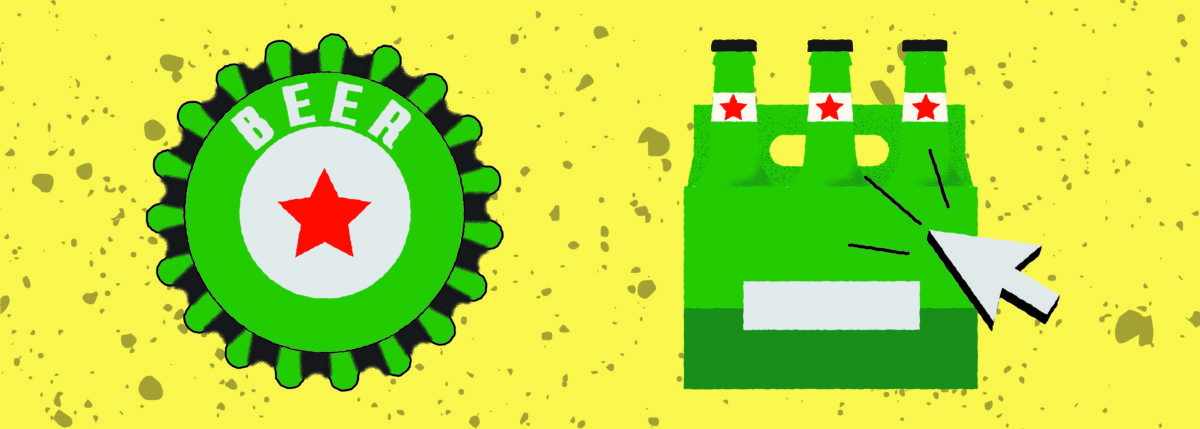Resources
How to Sell More Beer on Drizly
Portfolio Management and Best Practices to Increase Beer Sales on the “Fourth Tier”
Direct-to-Consumer eCommerce alcohol sales has been a growing trend for years. And the pandemic-induced lockdowns in 2020 might prove to have been the turning point this channel needed to go from niche service to an every day essential part of life. And this provides a great opportunity for brand building that many craft breweries are completely missing out on.
We caught up with Jay Sobel, Senior Data Analyst, at Drizly to discuss the platform, eCommerce best practices, larger beverage industry trends and what a small brewery can do to increase sales on this burgeoning “Fourth Tier” today.


Hi, Jay. Please introduce yourself, and tell us what you do at Drizly.
 Jay
Jay
Sure, I’m a Senior Data Analyst on Drizly’s analytics team broadly responsible for business intelligence around our marketplace operations. My manager and I support around eight teams; the most relevant ones to CODO’s audience are Inventory, and Catalog. I’m based in Boston. Right next to the Drizly office that I’ve never actually been inside!
Before Drizly I worked at a company called Wanderu which aggregated bus and train tickets — that was great until COVID. And before that, I was at LevelUp which builds branded mobile apps for fast-casual restaurant chains; their first-and-best customer was Sweetgreen, and they were acquired by Grubhub, becoming “Grubhub Enterprise” in 2018. So I’ve been at a few e-commerce aggregator companies with different relationships to their marketplaces.
Beer-wise, I was once a juicy NE IPA guy, but two years ago I was diagnosed with Celiac Disease so now I’m gluten-free, and drinking mainly hard seltzers, but at least I have a doctor’s note! I have a variety pack of Willie’s Superbrew in my fridge right now.

For those that don’t know, give us a rundown on Drizly itself. What is the business, where do you operate and why should people sign up today?
 Jay
Jay
Drizly is a website and mobile app for ordering on-demand alcohol delivery in the US and Canada, and we are the market leader in that category. The shopping experience is product first, or “brand first” as we say sometimes. Consumers browse a combined inventory of all the stores that deliver to their address, and then select a store to fulfill whatever products they’ve added to their cart. Coverage isn’t universal. There are a handful of states where the business model isn’t legal, and the best coverage tends to be in more densely populated areas.
As a business, Drizly is a three-sided marketplace consisting of Consumers, Retailers, and Suppliers (brands). Consumers come to Drizly for the convenience of on-demand delivery, to send gifts remotely, and to navigate the deep selection of products available across their local retailers. Retailers partner with Drizly to tap into that consumer demand, and because Drizly can digitize their inventories more completely than any other provider. And on the brand side there’s a basic level of merchandising products in the marketplace (which I’ll say more about in a second), and in development now are tools to spend advertising dollars to promote products within Drizly browse and search in really efficient, finely targeted ways.

In response to our 2021 Craft Beer Branding Trends review, you offered some quick ways breweries can step up their brand and portfolio management within Drizly to increase sales. Let’s discuss a few of those.
The first was simply adding images and doing a better job of populating their business’ profile. Can you elaborate on this?
 Jay
Jay
Let’s discuss—and thanks for the shoutout on your podcast!
The executive summary is that Drizly has a platform called Drizly Supplier where brands can manage their products in the Drizly catalog. It’s a simple interface for adding products and filling in their key details; images, descriptions, geographic regions, etc. And it’s the source of truth for recognizing those products on stores’ shelves, and displaying them to consumers. I ran an analysis around the impact of adding images that looked at products that gained an image at some point in the last year. In the four weeks before and four weeks after getting an image they saw an average 300% lift in add-to-carts. The cumulative benefit of adding products and their full suite of details tends to be multiples on brands’ sales.
In some ways this is a lot like merchandising products on Amazon, but one of the interesting differences is that Amazon merchants are fully responsible for merchandising their products, whereas Drizly built out a ton of product catalog itself over the years. There are 30k brands selling on Drizly, but only a few thousand brands are managing their own products’ imagery and brand story. And maybe it has already been implied, but Drizly’s catalog expansion tends to be quantity-over-quality, and prioritized in terms of individual products rather than brand portfolios.
I ran some numbers in the Beer category specifically. I wish I could have filtered it down to “craft beer” but we haven’t cracked that definition yet.
There are around 4,000 beer brands sold on Drizly. Just under a quarter of those brands have registered with Drizly Supplier. And less than 8% have made any edits to their products in the last six months. So that’s 92% of beer brands letting the largest digital marketplace in their industry figure itself out!


And for a tactical point, you mentioned SKU/UPC management being somewhat different on a third party delivery service than what a brewery might be used to in off-premise. How should breweries manage or think about their individual SKUs to sell more beer on Drizly?
 Jay
Jay
I think this question is about UPCs? The problem with SKUs is that they are generated randomly by whoever is keeping stock of products, so tech products working across stores can’t really get any information from a SKU. It’s only meaningful within the store or chain of stores.
UPC stands for Universal Product Code, and as the name implies it’s a consistent identifier of the product itself which can be recognized across different stores. In practice there’s often leading and trailing zeroes falling off in Excel, but it’s still the best bet for recognizing products, and it’s Drizly’s first source of truth for the identity of a product in a retailer’s inventory. It also means that products in the catalog with a UPC are instantly recognized when they are added to any retailer’s inventory.
I think the main way this system runs into trouble is when the definition “a product” varies between parties. For instance, a single can might have a UPC barcode printed on it, but if that can is sometimes held together in a pack of four , and sometimes in a pack of six with a lid-case, then there’s no way to distinguish the single can from the four pack and the six pack from Drizly’s perspective.
A more flagrant example is rotating Seasonal beers that just share the same UPC as they rotate. In those cases, Drizly shows a generic seasonal option, but the version available to the consumer will vary, and that can undermine the appeal of the product.
I’ve heard it costs a small fee to claim a new UPC, but it may be worth the cost to identify a product that will be stocked in third party marketplaces.

Any other best practices, or low hanging fruit, that breweries / Bev Alc folks can do right now to increase sales on Drizly?
 Jay
Jay
Linking from brand properties to brand filtered pages within Drizly can be a way to send people directly to a shopping experience from web. There are two ways to do that. The first is to link to the search results with the brand’s name. Willie’s Superbrew does this on their website. And the second option is the generated brand page: (tip: if those pages are blank you can open the page in incognito to see all the results). Every brand has that page generated, and it’s linked at the bottom of their individual product pages if the product has a description.
Willie’s also has links to Instacart, Wholefoods and Minibar. Play the field! We have a few competitors, and from a brand perspective it probably makes sense to keep a bookmark on Drizly Supplier and equivalents on Salsify, Minibar, or CityHive.
I think product photography has to be an increasingly important investment since that will undergird pretty much any digital representation. Creature Comforts is a good example of really clean product photos and they uploaded the same images to Drizly Supplier.
Lamplighter uses its can-art sans actual cans on Drizly. I haven’t tried to measure the efficacy of labels vs. actual cans, but I like that it’s a different approach. There may be some websites that let you upload artwork and download a render of a can with the artwork applied. That would definitely save some time, and probably be hard to distinguish from photographs of the physical product.

Are you seeing consumers trial new brands on Drizly or are people mostly buying 6/12-packs of brands they already know and trust?
 Jay
Jay
We find that 12-packs are more popular than 6-packs on Drizly. That probably has to do with the added costs of delivery which incentivizes larger volume orders at a lower frequency.
A consumer on Drizly with ten stores around them can have a combined selection in the tens-of-thousands of products. Personally, that leads me to shop ranking sites like this 2015 Gluten Free Beer ranking (which links directly to Drizly), or drill down through the categories and ‘related products’ pages. I find that much more pleasant than visually scanning up and down an aisle of shelves.
One sort of funny angle on this is that Drizly keeps track of your order history, so there’s no longer the problem of stumbling on a really great brand and later forgetting their name.


Build a stronger brand.
Sell more beer.
Join 7,500+ other beer industry folks and sign up for our monthly Beer Branding Trends Newsletter.

Beer Branding Trends 2.0

We’ve had a lot of conversations about beer packaging as it relates to DTC and online sales. Do you think the online medium should inform physical package design in some way or is that letting the tail wag the dog?
 Jay
Jay
Alcohol retail (off-premise) is only 5% online, compared to 12% of grocery, and 14% of retail in general. And cannabis puts everything else to shame with high double-digits online, especially in the illegal market. There’s probably some commentary in there on regulation and innovation, and an alternative timeline where prohibition stuck and alcohol was 100% digital by 2010… Back in this reality though, I don’t see any rush to build a digitally native beer.
Packaging-wise, beer seems pretty ideal for shipping and on-demand delivery. Cans are awesome. I recently discovered the Crowler in Vermont where I guess Growlers were banned and breweries replaced them with giant, single 32oz cans. Maybe those will catch on??
Design-wise, I think simpler designs look better in low-res images, and maybe they even fit in with modern web design more cleanly. High Noon is crushing on that front. I’m also out of my depth maybe in this whole question – I’ll have to keep reading your blog.
In the medium to long term I would love to see more abstract digital representations of products. I think ecommerce is generally optimized for a “lowest denominator” of consumers who still see online transactions as unsafe or risky and really need to see the physical object they are trying to buy on a white background. Growing up playing a lot of video games, I think there are much more imaginative possibilities, and I think the dialog around NFTs and the Metaverse is really starting to swing in this direction and discover a lot of repressed value in imaginative digital-first representations. Check out SAK3.

Is there a certain size a brewery should be before considering selling their beer on Drizly? (e.g. 5k bbls per year)
 Jay
Jay
They might already be selling on Drizly if they are on the shelves of a retailer who’s on Drizly. In that sense, there is no “go live” switch for the brand, and I don’t think there’s any downside to just being out there. There’s definitely upside to improving the quality of that presence in simple ways.

Is there a magic number of SKUs or of specific brands that a brewery should sell on Drizly or is this a case by case consideration? (e.g. if you launch with less than 3 SKUs you won’t see any traction)
 Jay
Jay
There’s a lot to be said about the digital shelf vs the physical shelf. One big idea is that the digital shelf is infinite, so having five SKUs vs twenty SKUs may be less important. I’ve read about P&G really intentionally dominating physical retail shelves and having to re-think those decisions as ecommerce grew in their vertical and DTC brands gained traction. In the near future on Drizly there may be advertising opportunities gated by having, say, five products available to fill a shelf (and I’m making that number up). But that might be the type of requirement that becomes more important than the percent of the physical shelf filled by one brand.

I’ve been following your BevAlc Insights Newsletter for a while now and think it’s valuable content for beverage producers. Is the analytics and insights side of Drizly a core feature, or a nice side benefit of having access to all that sales data? (I have a feeling I know the answer, given your title, but humor me).
 Jay
Jay
Haha—it’s definitely a core feature.
Internally, we’re leveraging our data to optimize the marketplace in really granular ways. On the operations side where I sit, there’s a lot of work done around store performance. We try to identify the features that matter most to consumers, and then nudge stores toward fulfilling that experience more consistently.
Externally, there are a lot of opportunities to productize our data. It’s actually a big challenge for a lot of marketplace companies. We know retailers and brands could benefit from having deeper analytics available, but we can’t just throw together a dashboard, share it with four thousand retailers, and change it a week later. There’s a different standard of experience externally than there is internally, not to mention the technical side of designing and building for web.
In the medium to long term I’m really excited to see if we can build in some insights to Drizly Supplier to help brands navigate their presence on Drizly, and have a place to check back after launching new products, or filling in product details. As Drizly’s advertising platform matures there will be tooling for smaller brands to promote their products within Drizly. Once that’s possible, I think brands will want to know not just what’s happening week-over-week, but what could be happening if they start pulling promotional levers.

Is there an opportunity for smaller craft producers to sell other value-added items that might pair well with their core brands to boost margin? I’m thinking an RTD cocktail brand that could sell a line of margarita salt. Or a liquor brand could offer bitters. Something along those lines?
 Jay
Jay
Sounds like an innovative new category: “Almost-Read-to-Drink”.
That’s a cool idea. It would hinge on retailers carrying both the anchor product and the add-on product. We have a whole category of “Extras” and with delivery minimums it often makes sense to buy the thing you want plus something that goes well with it to reach the minimum.

Tequila, RTD‘s, hard seltzer, beer, or ? What do you think will be the fastest category growth on Drizly over the next few years?
 Jay
Jay
Top line, Drizly sells more Liquor > Wine > Beer, and that’s with most Hard Seltzer under Beer (High Noon being Liquor: Vodka RTD, not a Hard Seltzer).
Relative to in-store purchasing, Drizly over-indexes on Japanese Whisky, Mezcal and subcategories of Gin within Liquor. Champagne, Sparkling Wine and Pink Wine within Wine. And Hard Seltzer, IPAs, Ciders, and Stouts in Beer.
If I was putting money down I’d say Mezcal will be up there. We are definitely going to see a lot of Tequila sales as well. Maybe Soju is an interesting bet? It tends to be flavored, just not a seltzer.

Do you have any book / podcast / blog recommendations that Bev Alc professionals should check out?
 Jay
Jay
CODO Design, of course.
Beyond these, I skim the Mark Brown newsletter when I have time, and we have a couple internal Slack channels dedicated to alcohol industry trends and marketplace business trends. I think the BevAlc Insight-ers have a better idea of what’s happening with industry trends than I do!

Build a stronger brand.
Sell more beer.
Join 7,500+ other beer industry folks and sign up for our monthly Beer Branding Trends Newsletter.
